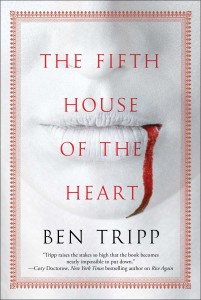
Ben Tripp
Gallery Books
July 28, 2015
Reviewed by Marvin P. Vernon
Asmodeus “Sax” Saxon-Tang is an aging antiques dealer who just outbid a woman on an over-priced antique clock in an auction. Later that night the clock is stolen and the watchman for Sax’s warehouse is murdered. Sax knows who wanted the clock and who would be willing to kill for it. Vampires! For Sax has tangled with them before. What he doesn’t know is why nor does he know that the particular vampire who would have a motive to steal it is the one who almost killed him before. Now Sax, despite his age and what he sees as having a natural cowardice tendency which is only beaten by his greed, will assemble a team and reclaim his prize even though he knows it may be the last thing he will do.
That is the starting premise of The Fifth House of the Heart which may be one of best vampire novels in years. It is certainly a trifle different than the recent horde of undead fiction. Tripp has already had his fling recasting zombies in the unconventional Rise Again novels and he seems to want to do the same thing with vampires. The author‘s vampires are close enough to be familiar but have their own little variations that make them different and interesting. Tripp’s vampires are ancient, basically natural creatures who are practically ageless yet they are, for the most part, solitary and vicious with a vain urge to collect priceless relics of the past which explains why an antique dealer would risk his life pursuing them. Crosses and garlic do not work but Sax and his fellow vampire hunters have their own special arsenal to battle the creatures’ unique physiology. And therein lies the clue to the book’s title.
But while Tripp’s take on vampires is intriguing, it is Saxon-Tang himself that pulls the story together. Sax is aging, vain, and a self-proclaimed coward yet his love for his work and his pronounced greed tempts him into putting his life at risk several times. It also places himself in the radar of the vampires. The third person narration is usually in the perspective of Sax so we gets a good perspective of his motives and his own conflictual views of his life and his goals. It is that conflict that drives his mission while he seeks out help from the Catholic Church, worries about his niece who seems to be the only person that can pull him out of his self-centered thoughts, and lusts after the young monk that the church orders to accompany him on his quest.
The action in The Fifth House of the Heart is impeccable, moving at lightning speed. It is the best part of the book. Two scenes take place as flashbacks, one in 1965 and another in 1989. The rest of the book, and the climatic ending, takes place in present day. It is these very exciting parts of the novel that highlight one of the book’s weakness: once the horror is done, much of the rest of the novel seems like set-ups for the thrills. We follow Sax’s journey and his collection of his team yet despite some very clever writing and dialog we yearn for the meaty parts. Except for the young monk Paolo, the rest of the team feels like filler.
Fortunately when all is done and bled, there ends up more meat than fat. Sax may have flaws and be slightly sleazy but he is very clever and sometimes wise. He embodies us older people who are set in our ways yet still have room for improvement. I just hope I do not need to battle vampires to find that improvement. Overall The Fifth House of the Heart is a welcome addition to the vampire genre and if it tends to drag a little too much in parts for my taste, it is still a rollicking bloody epic of a story.
- Slices – Book Review - September 27, 2017
- A Debt to be Paid – Book Review - September 26, 2017
- The Darklights – Book Review - September 21, 2017
- Pacific Rising – Book Review - July 28, 2017
- Palladium at Night – Book Review - July 17, 2017
- Apartment 14F – Book Review - May 31, 2017
- Final Girls – Book Review - May 26, 2017
- Creepshow – Book Review - May 8, 2017
- Exorcist Falls – Book Review - April 10, 2017
- The Wild Harmonic – Book Review - March 20, 2017


